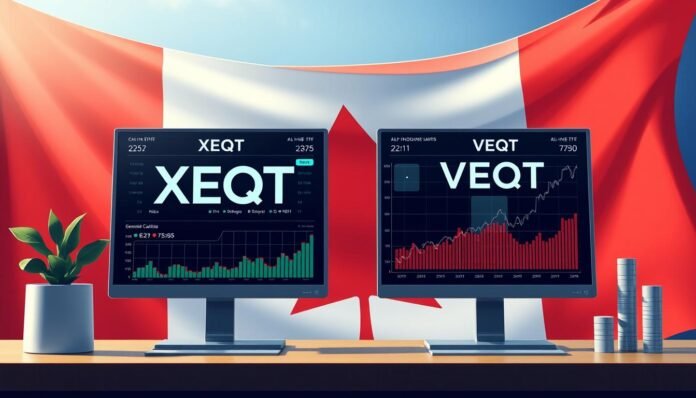XEQT vs VEQT: Which All-in-One ETF Is Best for Canadian Investors in 2025?
Canadian investors looking for a mix of global stocks often turn to all-in-one ETFs. The iShares Core Equity ETF Portfolio and the Vanguard All-Equity ETF Portfolio are two top picks. They aim to give broad stock market exposure, perfect for those investing for the long haul.

When picking between these ETFs, it’s key to look at fees, diversification, performance, asset allocation, and risk profile. For example, the iShares Core Equity ETF Portfolio has a Management Expense Ratio (MER) of 0.17%. On the other hand, the Vanguard All-Equity ETF Portfolio has an MER of 0.20%. More details on these ETFs and their performance can be found on Cashflow Capitalist.
Key Takeaways
- Both XEQT and VEQT offer broad exposure to global equities.
- MERs for XEQT and VEQT are 0.17% and 0.20%, respectively.
- Investors should consider their individual financial goals and risk tolerance.
- Performance and asset allocation are key when choosing an ETF.
- It’s important to check the tracking error and average daily volume.
Understanding All-in-One ETFs in Canada
In recent years, all-in-one ETFs have become popular in Canada. They make it easy to diversify your investments. This suits many different investment strategies.
What Are All-in-One ETFs?
All-in-one ETFs offer a single, diversified investment. They mix different asset classes, like Canadian and international stocks, and bonds. This mix helps reduce risk and makes managing your portfolio easier.
The Rise of All-in-One ETFs in Canadian Markets
All-in-one ETFs are gaining popularity in Canada. They are easy to use and cover a wide range of investments. This makes them a great choice for those looking to invest in various markets with one product.

Why XEQT and VEQT Stand Out
XEQT and VEQT are top all-in-one ETFs in Canada. They are known for being low-cost and having a wide investment strategy. This makes them appealing to those looking for a diversified portfolio.
XEQT vs VEQT: Core Differences Explained
Choosing between XEQT and VEQT depends on several key factors. These include their management companies and expense ratios. It’s vital for Canadian investors to understand these differences to make informed decisions.
Provider Background: BlackRock (iShares) vs Vanguard
XEQT is managed by BlackRock’s iShares, a top global ETF provider. On the other hand, VEQT is managed by Vanguard, famous for its low-cost index funds. Both companies are well-respected, but they have different approaches. BlackRock’s iShares offers a wide range of ETFs, while Vanguard focuses on low-cost investment products.
Management Philosophy: BlackRock aims to provide a wide variety of ETFs for different investment strategies. Vanguard, on the other hand, focuses on low-cost index investing.
Management Expense Ratio (MER) Comparison
The management expense ratio (MER) is a key factor in choosing between XEQT and VEQT. XEQT has an MER of 0.20%, which is slightly lower than VEQT’s 0.22%. This small difference can affect long-term investment returns.
| ETF | MER |
|---|---|
| XEQT | 0.20% |
| VEQT | 0.22% |
Fund Structure and Holdings
XEQT and VEQT have different holdings and structures. This affects their performance and diversification. XEQT tracks the FTSE Canada All Cap Index, while VEQT tracks the FTSE Canada Universe All Cap Index. Both indexes cover the Canadian market, but they have different stocks and weightings.
Diversification Benefits: Both ETFs offer diversified exposure to the Canadian market. But, the specific holdings and their weightings can lead to differences in performance.
Trading Volume and Liquidity
Trading volume and liquidity are key for investors who need to buy or sell shares quickly. Both XEQT and VEQT are highly liquid ETFs. But, their trading volumes can vary.

Recent data shows XEQT has a slightly higher average trading volume than VEQT. This makes it easier to trade large quantities without significantly affecting the market price.
“Liquidity is a critical factor in ETF investing, as it affects the ease of buying and selling shares.” – Investment Expert
In conclusion, while both XEQT and VEQT are good options for Canadian investors, their differences are important. These include management company, MER, fund structure, and trading volume.
Asset Allocation and Diversification Analysis
Canadian investors looking at XEQT or VEQT need to know about their asset allocation and diversification. Both ETFs offer a mix of investments, but they do it in different ways.
Geographic Exposure Breakdown
XEQT focuses more on U.S. stocks, which might appeal to those wanting to tap into the biggest economy. VEQT, on the other hand, balances Canadian, U.S., and international stocks. This balance could help spread out risks.
Financial experts say diversifying across different regions can lessen the impact of market ups and downs. For more insights on Canadian ETFs, investors can explore various strategies.
Sector Allocation Differences
The sectors XEQT and VEQT focus on differ, showing their unique investment strategies. XEQT puts a lot of weight in tech and healthcare, big in the U.S. market. VEQT, by contrast, spreads its bets across more sectors, aiming for steadier returns.
Canadian vs US vs International Weighting
VEQT has a big chunk of Canadian stocks, which might appeal to those with a home bias. XEQT, on the other hand, has more U.S. and international stocks. This gives investors a different mix of risks and rewards.
Emerging Markets Exposure
Both XEQT and VEQT have some exposure to emerging markets, but VEQT has a bit more. This could be attractive for those looking to invest in growing economies.
In summary, XEQT and VEQT cater to different investor needs with their asset allocation and diversification. By understanding these differences, Canadian investors can make choices that fit their goals and risk comfort.
Performance and Risk Assessment
Evaluating XEQT and VEQT is key for investors in 2025. Both ETFs have shown strong historical returns. Yet, their risk levels and dividend yields differ.
Historical Returns Comparison (2020-2025)
Looking at XEQT and VEQT’s returns from 2020 to 2025 is vital. Both have given impressive returns, but with some differences.
| Year | XEQT Return (%) | VEQT Return (%) |
|---|---|---|
| 2020 | 12.1 | 11.9 |
| 2021 | 15.3 | 15.1 |
| 2022 | -3.2 | -3.0 |
| 2023 | 8.5 | 8.3 |
| 2024 | 10.2 | 10.0 |
| 2025 (YTD) | 5.1 | 5.0 |
Volatility and Risk Metrics
XEQT and VEQT’s volatility and risk are important. XEQT has a slightly higher standard deviation than VEQT, showing slightly more volatility.
Standard Deviation: XEQT – 10.2%, VEQT – 10.0%
Beta: XEQT – 1.02, VEQT – 1.01
Performance During Market Downturns
Both ETFs have shown strength during downturns. In 2022, they both declined by 3.2% and 3.0%, respectively.
Dividend Yield and Distribution Schedules
XEQT and VEQT offer attractive dividend yields. XEQT yields 2.5% and VEQT yields 2.4%. They distribute dividends quarterly, providing regular income.
In conclusion, XEQT and VEQT have similar returns but differ in risk and dividend yields. Investors should weigh these factors when choosing between the two ETFs.
Investor Profile: Who Should Choose XEQT vs VEQT
Choosing between XEQT and VEQT depends on your investor profile and strategy. Both ETFs offer a mix of stocks, but they meet different needs and tastes.
Pros and Cons of XEQT
XEQT, managed by BlackRock, focuses on U.S. equities. This is great for those wanting growth, as the U.S. market often gives big returns.
- Pros:Strong U.S. market exposure
- Competitive management expense ratio (MER)
- High liquidity
- Cons:Potential for higher volatility due to U.S. market concentration
- Less global diversification compared to some other ETFs
Ideal Investor for XEQT
XEQT is for investors who want growth and are okay with more U.S. stocks. It’s perfect for those believing in the U.S. market’s future and seeking a simple, affordable investment.
Pros and Cons of VEQT
VEQT, by Vanguard, has a balanced global allocation. This can lower volatility and offer a wide investment mix.
- Pros:Global diversification
- Lower volatility due to balanced allocation
- Vanguard’s reputation for low-cost investing
- Cons:May not offer the same level of U.S. market exposure as XEQT
- MER, though competitive, might be slightly higher than XEQT’s
Ideal Investor for VEQT
VEQT is best for those wanting a balanced investment. It’s good for diversifying across global markets and reducing risks from market swings.
Growth-Focused vs Balanced Investment Approaches
Choosing between XEQT and VEQT depends on your investment style. XEQT suits a growth-focused strategy, while VEQT is better for a balanced approach.
Long-Term Investment Strategy Considerations
The right choice between XEQT and VEQT depends on your long-term plan. Think about your risk tolerance, investment time frame, and financial goals.
By weighing these factors and knowing the pros and cons of each ETF, Canadian investors can make a smart choice for 2025.
Tax Efficiency and Account Placement Strategy
Tax efficiency is key in investment choices, more so for Canadians aiming to boost their portfolios. It’s important to know how all-in-one ETFs like XEQT and VEQT perform in various accounts.
TFSA Considerations
Investing in a Tax-Free Savings Account (TFSA) with XEQT or VEQT can be smart. This is because your earnings grow without being taxed. Yet, remember that TFSAs have contribution limits and penalties for over-contributing.
RRSP Optimization
Registered Retirement Savings Plans (RRSPs) let you deduct contributions from your income. This can lower your taxable income. XEQT and VEQT are good for RRSPs, as they offer a diversified portfolio in a tax-deferred setting.
Non-Registered Account Tax Implications
In non-registered accounts, the tax effects of XEQT and VEQT vary. This is because of their holdings and distribution policies. Investors need to think about how capital gains and dividend income affect their taxes.
Foreign Withholding Tax Impact
Both XEQT and VEQT hold international securities, which might face foreign withholding taxes. Knowing the withholding tax rates and their impact on returns is vital for investors.
By understanding the tax effects of XEQT and VEQT in different accounts, Canadian investors can make better choices. This helps in optimizing their investment plans.
Conclusion: Making Your Decision in 2025
Canadian investors have a big choice to make between XEQT and VEQT. These are two top all-in-one ETFs. The right pick depends on what you want to achieve, how much risk you can take, and your investment plan.
Knowing what each ETF does well and not so well is key. Investors should look at fees, how diversified the portfolios are, how they perform, their asset mix, and tax efficiency. These details help match an ETF with your goals.
Comparing XEQT and VEQT shows they both have diverse portfolios. But, differences in fees, structure, and trading volume might affect your returns. Thinking about these points helps choose the best ETF for you.
In short, studying XEQT and VEQT helps Canadian investors make smart choices in 2025 and later. This ensures their investments support their long-term financial dreams.
FAQ
What are the main differences between XEQT and VEQT?
XEQT focuses more on U.S. stocks. VEQT spreads its investments across Canada, the U.S., and other countries.
Which ETF provider is more reputable, BlackRock or Vanguard?
Both are well-respected. BlackRock manages XEQT, while Vanguard oversees VEQT.
What is the management expense ratio (MER) of XEQT and VEQT?
XEQT has a lower MER than VEQT. This makes XEQT a cheaper choice for investors.
How do XEQT and VEQT perform during market downturns?
Knowing how they handle downturns helps investors understand their risks.
What are the tax implications of holding XEQT or VEQT in different types of accounts?
Tax rules vary by account type. Investors should think about foreign withholding tax.
Which ETF is more suitable for investors looking for significant exposure to U.S. equities?
XEQT is better for U.S. equity exposure.
What is the dividend yield and distribution schedule of XEQT and VEQT?
Dividend yield and schedules affect income. This information helps investors decide.
How do XEQT and VEQT differ in their sector allocations?
Their sector focus impacts performance and diversification.
What are the benefits of using all-in-one ETFs like XEQT and VEQT?
These ETFs offer a single, diversified product. They meet various needs and are easy to use.
How do XEQT and VEQT perform in terms of historical returns?
Looking at their returns from 2020 to 2025 gives insights into their performance.




